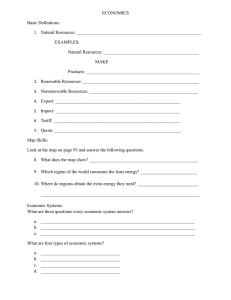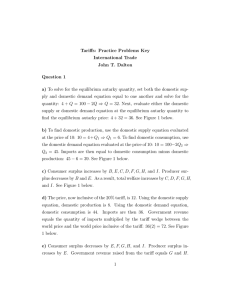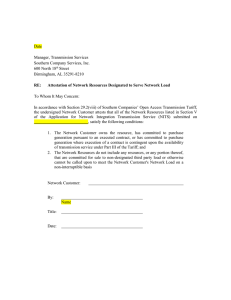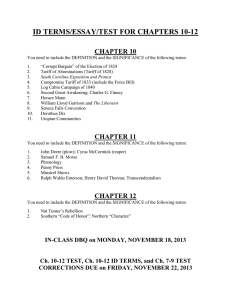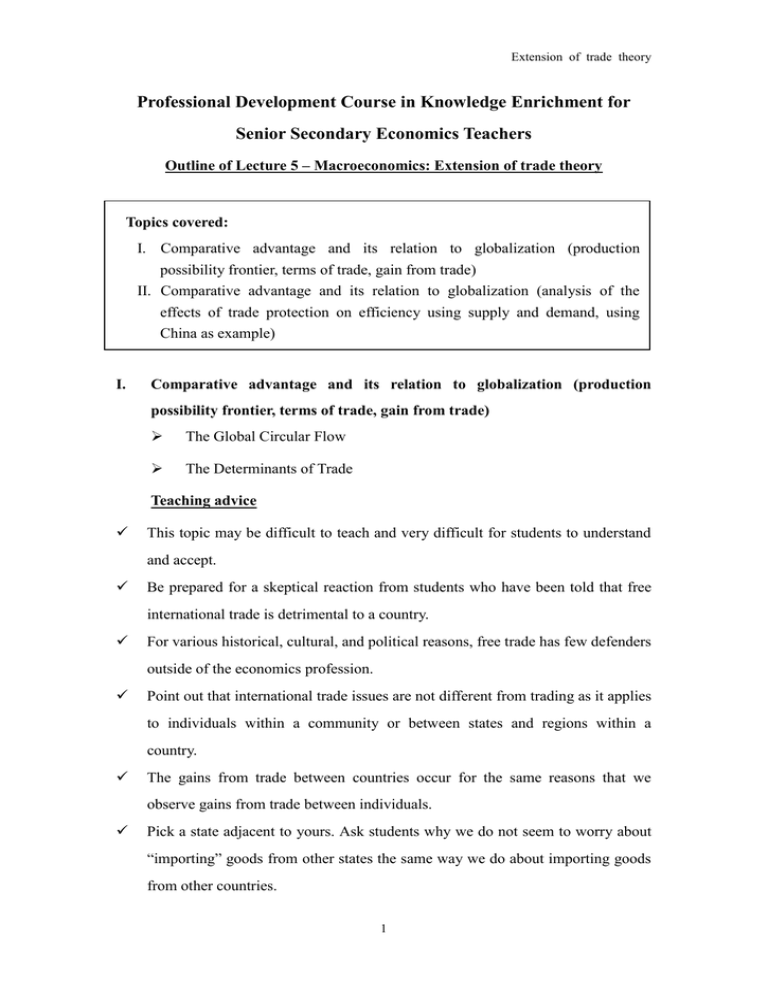
Extension of trade theory
Professional Development Course in Knowledge Enrichment for
Senior Secondary Economics Teachers
Outline of Lecture 5 – Macroeconomics: Extension of trade theory
Topics covered:
I. Comparative advantage and its relation to globalization (production
possibility frontier, terms of trade, gain from trade)
II. Comparative advantage and its relation to globalization (analysis of the
effects of trade protection on efficiency using supply and demand, using
China as example)
I.
Comparative advantage and its relation to globalization (production
possibility frontier, terms of trade, gain from trade)
The Global Circular Flow
The Determinants of Trade
Teaching advice
This topic may be difficult to teach and very difficult for students to understand
and accept.
Be prepared for a skeptical reaction from students who have been told that free
international trade is detrimental to a country.
For various historical, cultural, and political reasons, free trade has few defenders
outside of the economics profession.
Point out that international trade issues are not different from trading as it applies
to individuals within a community or between states and regions within a
country.
The gains from trade between countries occur for the same reasons that we
observe gains from trade between individuals.
Pick a state adjacent to yours. Ask students why we do not seem to worry about
“importing” goods from other states the same way we do about importing goods
from other countries.
1
Extension of trade theory
Definition of world price: the price of a good that prevails in the
world market for that good.
Illustration of comparative advantage and gains from trade with the aid of
production possibilities frontier - Constant cost analysis
Absolute Advantage
- Definition of absolute advantage: the comparison among producers
of a good according to their productivity.
Opportunity Cost and Comparative Advantage
Definition of opportunity cost: whatever must be given up to
obtain some items.
Definition of comparative advantage: the comparison among
producers of a good according to their opportunity cost.
Comparative Advantage and Trade
When specialization in a good occurs (assuming there is a
comparative advantage), total output will grow.
As long as the opportunity cost of producing the goods differs
across the two individuals, both can gain from specialization
and trade.
Production Possibilities Frontier
Y
PPF
0
X
2
Extension of trade theory
Illustration of comparative advantage and gains from trade with the aid of
production possibilities frontier - Increasing cost analysis
Differences in labor, labor skills, physical capital, land and
technology between countries cause productive differences, leading to
gains from trade.
These productive differences are represented as differences in
production possibilities frontiers, which represent the productive
capacities of nations.
Increasing cost analysis
Consumption
point
A: Consumption
point
Y
Food Production
B: Production point
Indifference Curve
Lines along which the market
value of output is constant.
A
Import
Food
Import
of Y
B
Lines along which the
Production point market value of output
is constant.
Isovalue line
PPF
X Production
Cloth
Cloth Exports
Export
of X
Note: Indifference Curve (analysis) is not required in Economics Curriculum (S4-S6)
3
Extension of trade theory
II.
Comparative advantage and its relation to globalization (analysis of the
effects of trade protection on efficiency using supply and demand, using
China as example)
Teaching advice
Be prepared for students to argue that trade cannot be good for everyone. More
than likely at least one of your students will know an individual who lost his or
her job when a factory closed and moved to another country.
Take this opportunity to point out that this individual is one of the “losers”, but
remind the class that the gains from trade exceed the losses, so the well-being of
society is increased.
The Winners and Losers from Trade
If the world price of Good X is higher than the domestic price, the
Country will export Good X. Once free trade begins, the domestic
price will rise to the world price.
International Trade in an Exporting Country
Price of
Good X
Domestic
supply
Price
after trade
World
price
Price
before trade
Exports
0
Domestic
quantity
demanded
4
Domestic
quantity
supplied
Domestic
demand
Quantity of
Good X
Extension of trade theory
How Free Trade Affects Welfare in an Exporting Country
Price of
Good X
Price
after trade
Exports
A
Domestic
supply
World
price
D
B
Price
before trade
C
Domestic
demand
Quantity of
Good X
0
The Gains and Losses of an Exporting Country
Before Trade
After Trade
Change
Consumer Surplus
A+ B
A
-B
Producer Surplus
C
B+C+D
+ (B + D)
A+ B+ C
A+ B+ C + D
+D
Total Surplus
The area D shows the increase in total surplus and represents the gains from trade.
If the world price of Good X is lower than the domestic price, the Country will import
Good X. Once free trade begins, the domestic price will fall to the world price.
International Trade in an Importing Country
Price of
Good X
Domestic
supply
Price
before trade
World
price
Price
after trade
Imports
0
Domestic
quantity
supplied
Domestic
quantity
demanded
5
Domestic
demand
Quantity of
Good X
Extension of trade theory
How Free Trade Affects Welfare in an Importing Country
Price of
Good X
Domestic
supply
A
Price
before trade
B
D
Price
after trade
C
World
price
Imports
Domestic
demand
0
Quantity of
Good X
The Gains and Losses of an Importing Country
Before Trade
After Trade
Change
Consumer Surplus
A
A+ B+ D
+ (B + D)
Producer Surplus
B+C
C
-B
A+ B+ C
A+ B+ C + D
+D
Total Surplus
The area D shows the increase in total surplus and represents the gains from trade.
Case Study: Cheap clothes from China
China’s Adaptation and Transformation under Globalization
The Path of China’s Accession to WTO
Why was China so eager to join WTO?
6
Extension of trade theory
The effect of a Tariff
Teaching advice
Divide students into groups and assign each group a section of the
discussion on tariffs or quotas.
For example, one group may be assigned the task of identifying changes in
the welfare of domestic consumers if there is a tariff, while another may be
assigned the same task with regard to domestic producers.
When groups are ready, have them present their analyses to the class.
This exercise will help you evaluate which students need extra help with
this material.
Definition of tariff: a tax on goods produced abroad and sold
domestically.
The Effects of a Tariff
Price of
Good X
Domestic
supply
Equilibrium
without trade
Price
with tariff
Tariff
Price
without tariff
0
Imports
with tariff
Q
S
Q
S
Domestic
demand
Q
Imports
without tariff
7
D
Q
D
World
price
Quantity
of Good X
Extension of trade theory
Consumer surplus & Producer surplus before tariff
Price of
Good X
Consumer surplus
before tariff
Domestic
supply
Producer
surplus
before tariff
Equilibrium
without trade
Price
without tariff
Domestic
demand
0
Q
S
Q
World
price
D
Quantity
of Good X
Imports
without tariff
Consumer surplus & Producer surplus after tariff
Price of
Good X
Price of
Good X
Consumer surplus
with tariff
A
Producer
surplus
after tariff
Equilibrium
without trade
Equilibrium
without trade
B
Price
with tariff
Price
with tariff
Tariff
Price
without tariff
0
Domestic
supply
Domestic
supply
Imports
with tariff
Q
S
Q
S
Domestic
demand
Q
D
Q
D
World
price
Price
without tariff
Quantity of
Good X
0
Imports
without tariff
Tariff
C
G
Imports
with tariff
Q
S
Q
S
Q
Imports
without tariff
8
Domestic
demand
D
Q
D
World
price
Quantity
of Good X
Extension of trade theory
Tariff Revenue
Price of
Good X
Domestic
supply
Tariff Revenue
Price
with tariff
Tariff
E
Price
without tariff
Imports
with tariff
0
Q
S
Q
Domestic
demand
S
Q
D
Q
World
price
D
Quantity
of Good X
Imports
without tariff
The Effects of a Tariff
Price of
Good X
Domestic
supply
A
Deadweight Loss
B
Price
with tariff
Price
without tariff
0
Tariff
C
D
E
G
F
Imports
with tariff
Q
S
Q
S
Domestic
demand
Q
D
Q
D
World
price
Quantity
of Good X
Imports
without tariff
Consumer Surplus
Producer Surplus
Government Revenue
Total Surplus
Before Tariff
After Tariff
Change
A+ B+ C + D + E + F
G
None
A+ B+ C + D + E + F+ G
A+ B
C+G
E
A+ B+ C + E + G
- (C + D + E + F)
+C
+E
- (D + F)
The area D + F shows the fall in total surplus and represents the deadweight loss of the tariff.
9
Extension of trade theory
The effect of an Import Quotas
Definition of import quota: a limit on the quantity of a good that can
be produced abroad and sold domestically.
The Effects of an Import Quota
Price of
Good X
Domestic
supply
Equilibrium
without trade
Domestic
supply
+
Import supply
Quota
Price with
quota
Equilibrium
with quota
Price
World
without =
price
quota
World
price
Imports
with quota
0
Q
S
Q
S
Domestic
demand
Q
D
Q
D
Quantity
of Good X
Imports
without quota
Price of
Good X
Domestic
supply
Equilibrium
without trade
Domestic
supply
+
Import supply
Quota
A
B
Price with
quota
Price
World
without =
price
quota
0
C
Equilibrium
with quota
E'
D
G
F
E"
World
price
Imports
with quota
Q
S
Q
S
Domestic
demand
Q
D
Q
D
Quantity
of Good X
Imports
without quota
Before Quota
After Quota
Change
Consumer Surplus
A + B + C + D + E’ + E’’ + F
A+ B
- (C + D + E’ + E’’ + F)
Producer Surplus
G
C+G
+C
None
E’ + E’’
+ (E’ + E’’)
A + B + C + D + E’ + E’’ + F + G
A + B + C + E’ + E’’ + G
- (D + F)
License-holder surplus
Total Surplus
10
Extension of trade theory
Comparison of Tariff with Quota
Tariff
Quota
Domestic price of the good
Welfare of domestic consumers
Welfare of domestic producers
Deadweight loss
(Potentially cause a
larger deadweight
loss than a tariff,
depends on the
mechanism used to
allocate the import
licenses.)
Others
Raises revenue for
Creates surplus for
the government
license holders
Comparative advantage and its relation to globalization
Teaching advice
This section provides a good opportunity to review what the students have
learned so far about trade.
You should reinforce the idea that total surplus rises when trade is
introduced, but falls once trade restrictions are imposed.
Globalization - The process of increasing interdependence among
countries and their citizens.
Economic globalization - The process of increasing economic
interdependence among countries and their citizens.
References:
Mankiw, N G (2006), Principles of Economics, 4th edition, Thomson,
South-Western. Chapter 3, 9
Case, K E, Fair, R C, (2007), Principles of Economics, 8th edition, Pearson,
Prentice Hall. Chapter 35
Hong Kong Trade Development Council: http://www.hktdc.com/tc/
11

